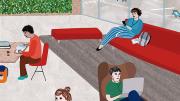It was late November and deadlines were landing thick as snow when I shocked myself in the Smith Campus Center. As electric shocks go, this one was mild; not watching where my hands were headed, my fingers only brushed the edge of the electrical outlet. A sensation not unlike several shots of espresso crashed through my body. Neat, I thought, and then, a second later, ouch.
A friend and I had spent our night writing papers under the fluorescent cap of Lamont Library. Alongside either the most diligent or most procrastinating of our fellow students we’d watched the sun rise and our productivity fall into a gradual scroll through the alternate realities offered by Facebook, Twitter, Instagram. There are only so many hours that a person can admire the light sluicing off of the neon signage of the Hong Kong restaurant, so near 8 a.m. we agreed that it was probably time to move on.
This semester the Smith Center, transmogrified from Holyoke Center (see “Harvard Hubs,” November-December 2018, page 24), has provided Harvard undergraduates with a spacious new answer to the well-worn question, “Where will I migrate to conquer the end of this paper?” With its Jetsons-shaped seating options and soaring glass walls, Smith has emerged from the center of Harvard Square like the most beautiful of mid-century modernist greenhouses. Or, as one friend pointed out, much like an airport terminal.
We were walking through the passageway that connects Massachusetts Avenue and Mount Auburn Street when she made that particular observation. Students sat or stood doing just what we were: huddling inside their winter coats, backpacks or lattes at their feet, all the better to observe others observing them. She’s right, I thought. We all look like passengers, waiting out a short delay.
Partly this is because, by design, Smith’s selection of fast-casual restaurants tends to attract a number of people who are not enrolled at Harvard at all. People like my parents, who were impressed by the blooming wall of plant life, and also people like the writers at food and entertainment site Boston.com, which produced a glowing review of the center’s astronomically-priced food options, none of which at the moment are available for purchase with student Crimson Cash.*
It seems intuitive that the University would try to create a lucrative as well as beautiful “front door” experience for campus visitors and students alike. Maybe for this reason, certain activities—napping, for one, and tabling, the easiest and most reliable act of student politics—are forbidden in Smith, while being allowed in other locations. Students may doze off in a library for hours without being disturbed, or set their posterboards in the front of Annenberg dining hall for as long as their improv troupe, faith-based organization, or divestment campaign so desires. But nobody really declares that they are going to the library to sleep (well, mostly) and fewer come to the dining hall hoping to learn about fossil fuels. These tactics are simply the ways we’ve managed to fit ourselves, our sleeping hours, and our political agendas into already packed schedules.
But when the stickiness of student life—the unkempt hours and occasionally intrusive campaigns—are discouraged from taking place in those areas created for student activity itself, then a further gulf is created between how we work and how the University would like the world to think we are working.
When I spoke with Sruthi Palaniappan ’20, president of the Harvard Undergraduate Council (UC), she laughingly rebuffed my airport analogy. She pointed out the ways in which the new center has been designed for the maximum utility of, and actually was being greatly enjoyed by, the student body at large. By the time we spoke at the end of December, the cantilevered glass walkways and raised stage had already played host to a student formal and several arts events; more arts rooms and performance spaces were tucked, beehive-like, within the soaring walls of the building. The UC’s appropriately named Signs and Symbols Committee was, she said, already collaborating to ensure that all cultural and identity organizations felt comfortable using the space—for example, for this year’s performance of the annual dance spectacular Ghungroo, hosted by the South Asian Association (SAA). And, of course, the offices of the UC are there. “I like using the center,” she said, “In fact, I’ve barely left it this semester.”
I, too, have barely left Smith Center this semester. In fact, I sought it out for exactly the atmosphere of competitive, comparative productivity that my friend described as “airport-like.”
As I spoke with Sruthi, an earlier conversation came to mind—one that had taken place during my own time as a UC representative. The center had yet to open, but proposals for its use were already circulating. Someone suggested that the space could be home to a long-sought multicultural center; and if not that, then it might be regarded as a kind of student union. Judging by the number of events already hosted there since the center opened, it seems that cultural organizations, student arts, and student politics have in fact all begun to coincide.
Yet despite the apparent success of activities that Sruthi described, I felt that something had been forgotten.
My freshman year I gave tours of the campus’s most memorable buildings—even before I’d properly come to inhabit them myself—to groups of curious international visitors, families, and prospective students. I explained that the system of Houses, with their lotteried placement of students into smaller communities, were meant to level out what otherwise might be an intimidating landscape of social clubs and centuries-old intelligentsia. Tourists are generally impressed by the wide variety of spaces available to students, and after hearing descriptions of T.S Eliot’s dorm room or being shown to Widener’s front door, they generally want to see where the studying happens.
I remember when one of my tour members asked about a student union. Did it exist? Could they see inside? And as I began, instinctively, to gesture at an object that wasn’t there, I realized it for myself: at Harvard there was no such place.
Strictly speaking, this isn’t quite true. Although few members of the class of 2019 will remember it, the Student Organization Center at Hilles (SOCH) used to be called by another name. As Hilles Library, the concrete structure in the Quad was, in the words of one 1966 Crimson review, “the first University library designed to make studying a pleasure.” The SOCH, however, is barely used these days—and then only for events, like an autumn graduation ceremony for off-cycle students, that feel distinctly mismatched to its gray-carpeted, corporate space. When a friend hosted an open-mic there, gathering artists of color from across the Harvard community at substantial distance from the Old Yard, the SOCH felt like a place to export those events that don’t quite fit within the mainframe of Harvard’s identity.
As early as 1973, Harvard students lobbied for the creation of a different kind of student space. A multicultural center might be dedicated to identity groups including the Black Student Association, Fuerza, SAA, the LGBTQ Center, and many, many others. Until this year, one distinguishing feature of a “minority” organization’s center on campus has been location: underground. Resources for female-identifying students are still tucked beneath the supposedly riot-proof structure of Canaday dormitory; the office for LGBTQ life only recently moved from the basement of Boylston Hall into a common room in Grays. The Harvard Foundation, meanwhile, still shares real estate with the Thayer laundry room.
Salma Abdelrahman ’20, who has led the most recent charge for a multicultural center, told me that her ideal would be “a space that could be used at all hours of the day to hang out—and transformed into events space when necessary.” Crucially, the place would promote not only a sense of belonging for students, but also an environment for ideas and people to meet, for resources to be exchanged. But this was only her suggestion; she was resigned that it would be some time before it could be implemented.
I’d met Salma, now vice president of Phillips Brooks House Association, the main undergraduate community-service organization, for the first time in another context: a weeklong training led by student activists from across the campus. Student organizers from the labor solidarity movement, undocumented students’ coalition, fossil-fuel divestment campaign, and Palestine Solidarity Committee, among others, came together in the wake of the 2016 presidential election for a meticulously organized program of teach-ins and reflective exercises. We met in Boylston Hall, awkwardly cramming into the rows of the Fong Auditorium, or arranging ourselves at desks in a mimicry of the professor-to-pupil relationship, even though we were really just trying to learn from one another. Friendships were made and information was exchanged, but the session had felt stunted, both by space and by time, and when the time was up, we each melted off to our respective squares of the campus, connected by email chain or dining-hall meals. As the semester went on these correspondences tapered off, reduced to signatures on letters of solidarity that indicated the proximity of, if not actual participation in, one another’s efforts.
Nearly two years later, Salma and I sat at a side table in Smith Center, where a draft of frigid air kept us both adjusting our jackets. We both scanned the light-catchingly beautiful space. Could the place possibly be the home for a new multicultural center? “No,” the student activist said, gazing at the salad joint across the way, “This isn’t the place.”
Much earlier in the semester, I took the elevator all the way up, bringing my books to sit in front of the wide windows that boasted a tenth-floor view, when things were sunny, of Boston itself. Someone, joking, had told me that Harvard College dean Rakesh Khurana had made a comment about being able to see into every final club from right here. It seemed funny at the time, but working at the top of the campus (which is what Smith Center now has come to be), I reflected on the fact that even this seemed to be missing the point: it wasn’t that students needed another space to regard one another from. We have plenty of perspective, meaning distance, already. What we need, and what we are perhaps in the process of creating, is a place where we can speak to one another—and be heard.
I no longer give campus tours, but if I did, I’d probably say, “The Smith Center is the newest answer to a well-worn question….”
*Editor's update: All the restaurants now accept Crimson Cash.









